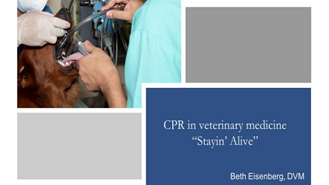
Stayin Alive!: CPR in Veterinary Medicine
Course Details
This lecture has been RACE Approved for 1 CE hour for veterinarians and veterinary technicians.
Every veterinarian and technician must be trained to recognize and respond to cardiopulmonary arrest. Cardiopulmonary resuscitation (CPR) is an essential skill that must be taught – and re-taught – throughout our careers. The American Heart Association publishes updated CPR guidelines for humans every 5 years, most recently in 2010. The International Liaison Committee on Resuscitation (ILCOR) has also played a major role in training medical professionals and lay people in CPR. These guidelines and training modules are helpful starting points for veterinarians, but they are designed for human, not veterinary victims of cardiopulmonary arrest. Until recently there was not a comprehensive document that addressed all aspects of CPR in veterinary medicine. In June 2012, the Reassessment Campaign On Veterinary Resuscitation (RECOVER) was released as a special edition of the Journal of Veterinary Emergency and Critical Care. The design of RECOVER is based on human initiatives that have compiled, analyzed, and drawn conclusions from a wide variety of laboratory and clinical research in people and laboratory animals. In order to increase the relevance for the veterinary community, veterinary clinical studies were added to the body of human medical literature used to create this historic document. At 130 pages, however, RECOVER is a potentially intimidating to most veterinarians. The goal of today’s lecture is to distill the recommendations into concise and relevant recommendations for CPR in general practice.